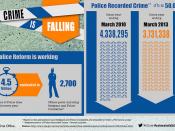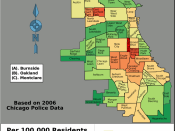It is comforting to know that, according to recent crime statistics, crime rates are dropping among adults. However, for teens the crime rate is soaring. Between 1990 and 1994, the rate at which adults age 25 and older committed homicides declined 22%; yet the rate jumped 16% for youths between 14 and 17. This age group surpassed the 18 - 24-year-old group in the early Oe90ùs as the most crime-prone. (Between 1986 and 1991, 18 - 24 showed a 62% increase in homicides; 14 - 17 showed a 124% increase in murders.) It is this age group that will be booming in the next decade (currently 39 million under 10).
However, the American Civil Liberties Union, in a fact sheet on juvenile crime published in mid May of this year, stated that contrary to public perception, the percentage of violent crimes committed by juveniles is low. According to one estimate, only 13% of violent crimes are committed by young people (Gallup Poll Monthly, Sept.
1994). The ACLU further suggests that the public also holds greatly inflated perceptions about the violence of today's juveniles, claiming only about 0.5% of young people commit violent crimes. ("Crime Time Bomb," U.S. News & World Report, March 25, 1996)
Current social trends do little to contradict the dire predictions made about youth crime rates. Nearly all the factors that contribute to youth crime -- single-parent households, child abuse, deteriorating inner-city schools -- are getting worse. At the same time, government is doing less (spending less) to help break the cycle of poverty and crime.
Predicting a generationùs future crime pattern is, of course, risky. Especially when outside factors remain unpredictable (Will drug use be up or down? Will gun laws be tightened?). Also, from year to year, crime rates can fluctuate much like the...


